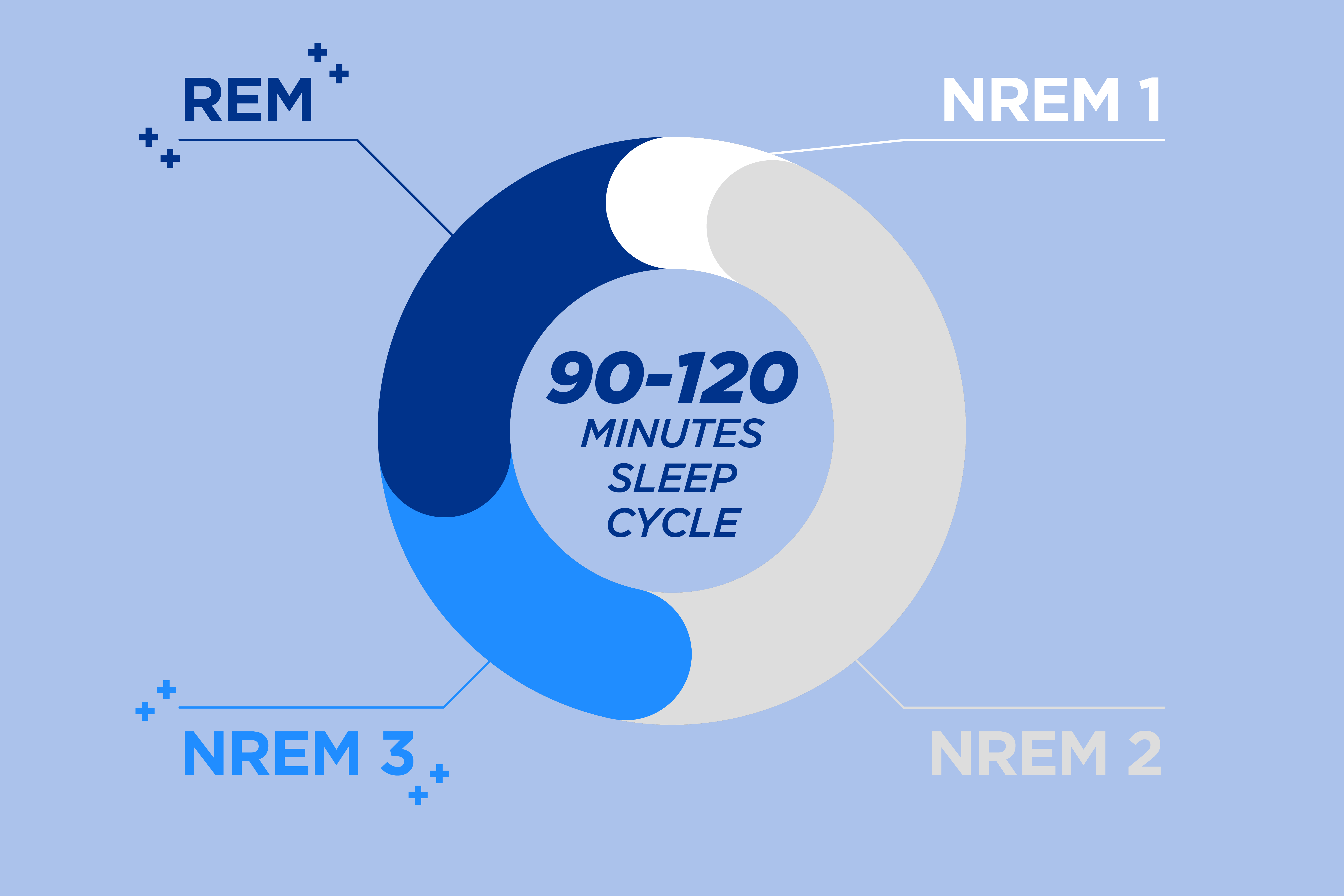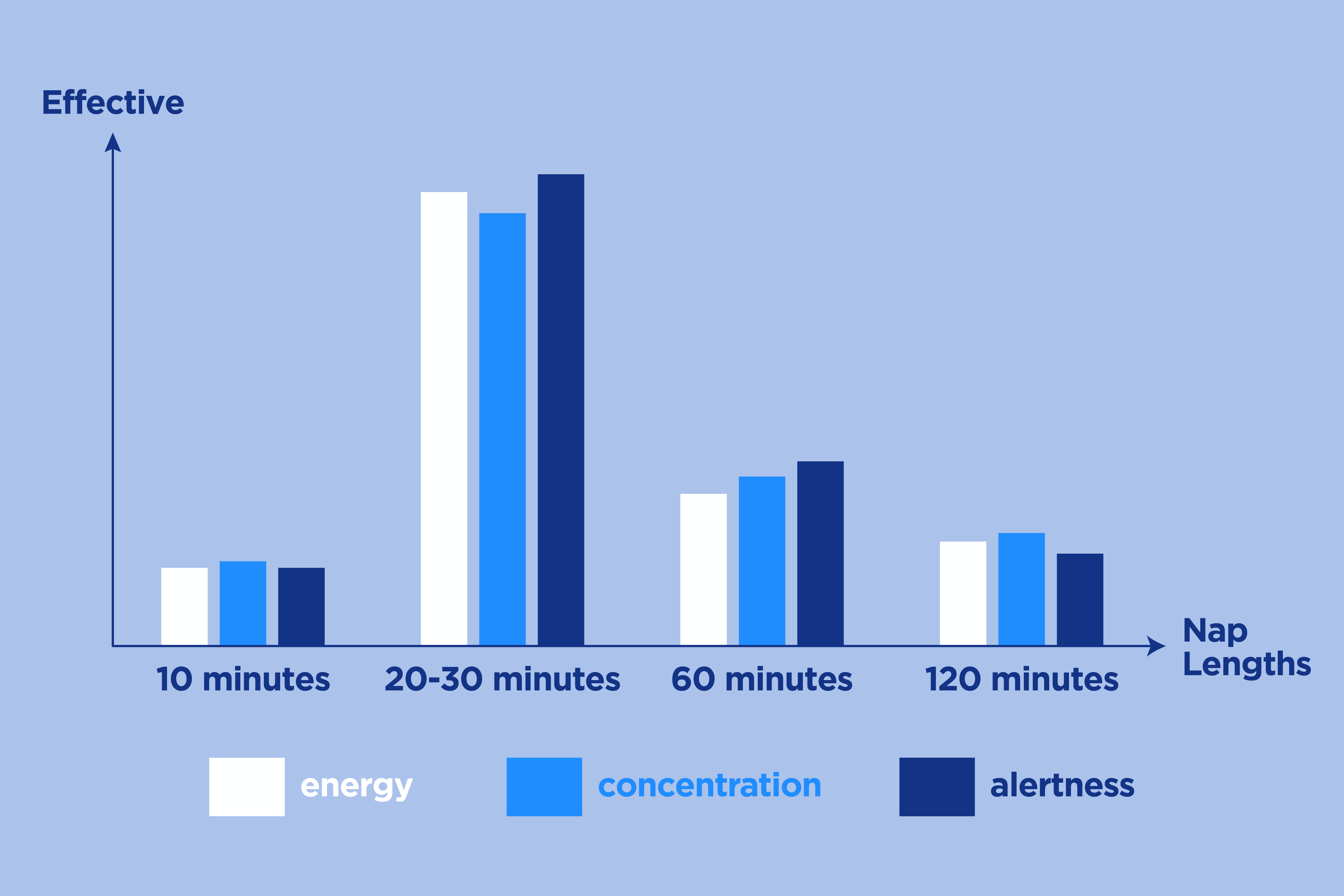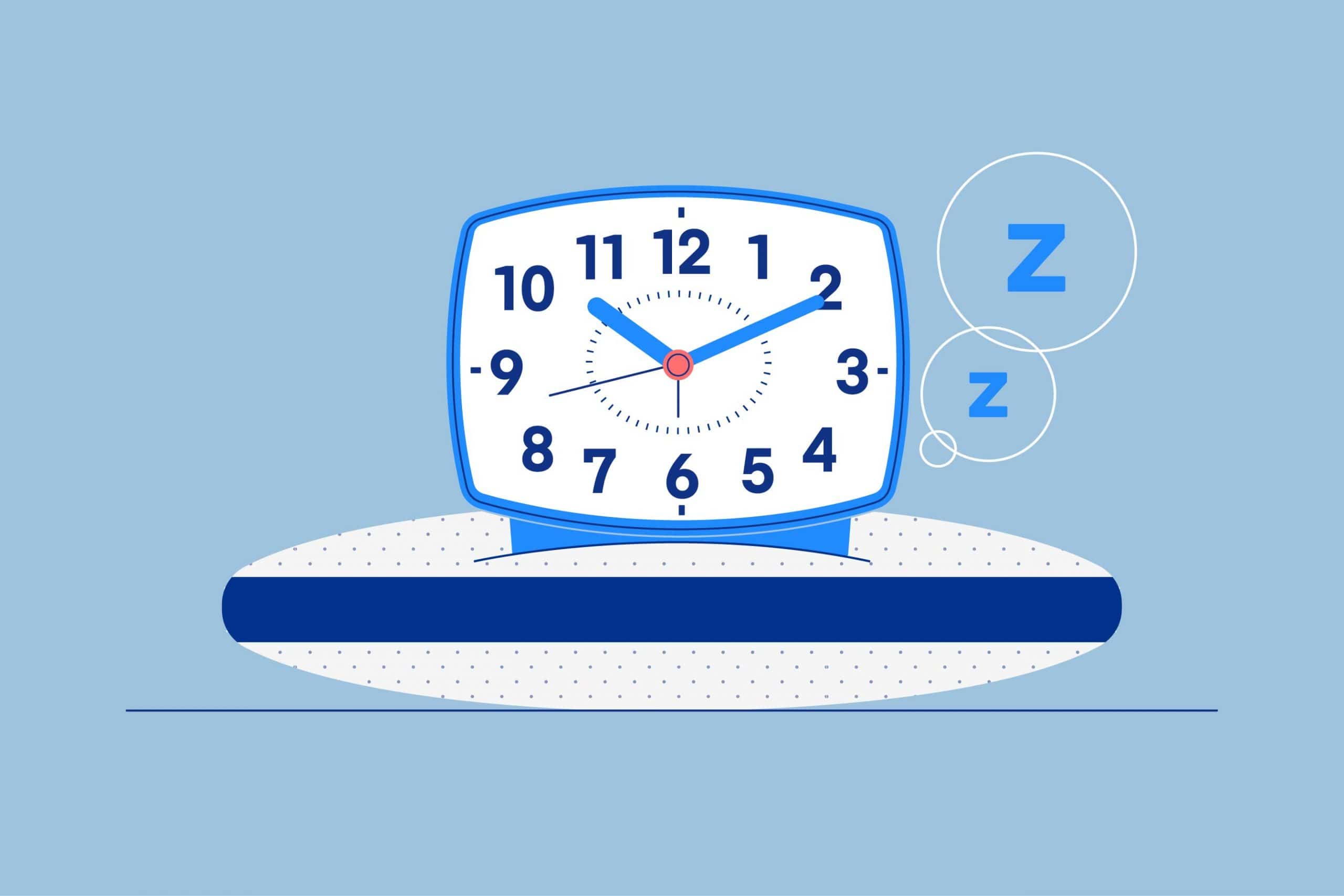Key Takeaways
- Understanding Sleep Cycles: Sleep is composed of different stages, and one complete sleep cycle lasts about 90 to 120 minutes. The stages include light sleep, deep sleep, and REM (rapid eye movement) sleep. These stages play different roles in memory consolidation and physical restoration.
- Ideal Nap Lengths: The effectiveness of a nap depends on its length. Short naps, around 10 to 20 minutes (often referred to as “power naps”), help prevent grogginess and can provide a quick energy boost. Longer naps may include deep sleep but can lead to sleep inertia upon waking. Napping for 90 to 120 minutes allows for a complete sleep cycle and can be refreshing but might interfere with nighttime sleep.
- Benefits of Napping: Napping, when done correctly, can offer several benefits, including improved alertness, enhanced cognitive performance, and mood regulation. Some studies even suggest that occasional napping may reduce the risk of heart disease. However, it’s essential to maintain a consistent nightly sleep schedule and use naps as a supplement, not a replacement, for nighttime sleep.
Regardless of how you slept the night before, some days, it can help to take a quick nap to reenergize and get the most out of your day. Not all naps are created equal. The length and timing of your nap can determine how you feel when waking up from your nap, and how quickly you fall asleep the following night. A perfectly timed nap won’t leave you feeling groggy and unfocused or disrupt your natural sleep-wake cycle.
In this article, we outline what science has to say about the best nap length.
What Is a Sleep Cycle?

To better understand the effects of napping, it is important first to understand the stages of sleep and how they work together to create one full sleep cycle.
One sleep cycle lasts about 90 to 120 minutes. If you sleep between 7 to 8 hours a night, you experience 4 to 5 cycles.
In stage 1, also known as “light sleep,” the brain transitions into sleep. It is a shallow stage, where brain wave activity begins to slow, and muscle tension starts to relax. This stage lasts about 5 to 10 minutes per cycle. NYC based sleep psychologist Dr. Joshua Tal says that during Stage 1, “a friend or family member can ask you if you are sleeping, and you would likely tell them ‘No’.”
Stage 2 sleep provides the bulk of sleep, where the heart rate and core body temperature drop, brain activity continues to slow, and we become less aware of environmental stimuli. Stage 2 can last for about 30 to 60 minutes per sleep cycle.
During stage 3, also known as “deep sleep” or “slow-wave sleep,” our brain waves slow down to a crawl. Researchers describe the shape of these brain waves as “delta waves”, because the waves slow to .5-4 per second (relative to 32 – 100 per second when we are awake and alert).
Delta waves reflect that our brain is working to clean out any waste and consolidate memory. HGH (human growth hormone) repairs and rebuilds muscle tissue. This stage lasts between 20 and 40 minutes per cycle, with higher amounts taking place in earlier cycles in the night.
Lastly, there is rapid eye movement or REM sleep. During REM, the body becomes immobile, brain activity increases usually in the form of dreaming, and the eyes begin a quick side-to-side motion known as rapid eye movement. Dr. Tal says, our body, “immobilizes itself so we don’t act out our dreams!” This stage only lasts about 10 minutes at the beginning of the night, but it gradually lengthens as the night goes on.
It is also important to note that sleep stages are not linear. REM sleep can begin at any time in the sleep cycle, and we may not always start each cycle at stage 1. Additionally, we may not move from stage 3 to REM automatically, but, instead, go back to stage 2 or 3 before entering REM.
However, in most cases, REM sleep starts about 80 to 90 minutes after falling asleep. We typically start each cycle in stage 1 or 2 and move through to stage 3, with intermittent periods of REM sleep taking place throughout.
However, because REM sleep lengths each time, the longer you sleep, the more REM sleep you experience, with the most occurring during the early morning between 3 am and 6 am.
Different Nap Lengths
Now that you understand the ins and outs of the sleep stages, let’s look at how they work during a nap.

The Power Nap: 10 to 20-Minute Nap
Studies Verified Source National Library of Medicine (NIH) World’s largest medical library, making biomedical data and information more accessible. View source show that 10 to 20 minutes is the perfect nap length, often referred to as a “power nap.” Sleeping for no more than 20 minutes means that you will likely stay in the 1st stage of sleep, light sleep, and you will still be somewhat aware of your surroundings as you nap. It may not be the most refreshing nap, but you will avoid waking up groggy.The Ideal Nap: 30-Minute Nap
If you nap for longer than 20 to 30 minutes, you will likely enter stage 2 of sleep. During stage 2, K-complexes (large brain waves) reduce the effects of environmental stimuli on the brain, helping us become detached from our environment so we can slip into the deeper stages of sleep.
If you wake up from a nap in the middle of stage 2, you may experience a small amount of what experts refer to as “sleep inertia.” This is defined as a period of extreme mental and physical grogginess, lethargy, and disorientation. Chances of sleep inertia Verified Source National Library of Medicine (NIH) World’s largest medical library, making biomedical data and information more accessible. View source in a 30-minute nap are low, and this amount can be a perfect balance between feeling refreshed and avoiding a nap hangover aka sleep inertia.
The Longer Nap: 60-Minute Nap
During a 60-minute nap, you will spend some time in stage 3 (deep sleep). Stage 3 sleep is incredibly beneficial. Memories and impressions are consolidated during this stage, and pertinent information is moved to the neocortex, the brain’s long-term memory storage.
However, waking during stage 3 will likely give you significant sleep inertia. You may experience sleep inertia and feel groggy for a period of time after waking.
The REM Nap: 90 to 120-Minute Nap
Napping for 90 to 120 minutes means you will get some REM sleep and potentially experience a full cycle of sleep. With a long nap, you will get all of the sleep cycle benefits without the risk of sleep inertia or grogginess when waking.
Although a longer nap can help you reenergize, it may interfere with your ability to fall asleep quickly at night. Therefore, if you notice that a long nap results in poor quality sleep at night, it is best to opt for a shorter nap between 20 to 30 minutes long. Dr. Tal says the ideal time to take a nap is between 1 and 3 p.m., around the time of the post-lunch energy dip.

Effects of Sleep Deprivation
Sleep deprivation can have significant negative effects on both physical and mental health. In the short term, lack of sleep can lead to daytime drowsiness, difficulty concentrating, impaired memory, and decreased cognitive performance. It can also weaken the immune system, making individuals more susceptible to illnesses.
Chronic sleep deprivation is associated with an increased risk of developing chronic conditions such as obesity, diabetes, cardiovascular diseases, and mental health disorders like depression and anxiety. Additionally, being sleep deprived can impact mood, leading to irritability, mood swings, and decreased emotional regulation.
For most people, it’s best to have a consistent sleep schedule and avoid naps to make up for a lack of sleep. However, there are some, such as night shift workers, who may need to use naps to reduce the effects of shift work sleep disorder. Daytime naps may also be necessary for sleep-deprived parents who are waking up with a baby multiple times in the night.
Frequently Asked Questions
Why am I more tired after a nap?
If you feel tired after a nap, it is likely because you woke up from your nap during stage 3 or REM sleep. A 20 to 30-minute nap will ensure that you wake up in a lighter stage of sleep, stage 1 or stage 2, and wake up feeling refreshed. If you need a longer nap, try to sleep for at least 90 minutes. This length of time will allow you to get some REM sleep.
Are naps good for your heart?
Evidence suggests a daytime nap once or twice a week could lower your risk of heart attack, stroke, or heart failure by as much as 48 percent. One study followed participants between the ages of 35 and 75 for 5 years. They found that, even though nap length varied, those who reported napping once to two times a week had a lower risk of heart disease than those who didn’t nap or those who napped 6 to 7 times a week.
What is the best nap length when you are sick?
When you are sick, your body is working to heal itself. Therefore, it is best to nap as much as possible and not worry about limiting your sleep time. This is one time when it is good for adults to nap.
What is the best time of day to nap?
To avoid disturbing your nightly sleep schedule, most sleep experts recommend napping between 1 p.m. and 3 p.m. Naps later than this could make it difficult for you to relax and get to sleep on time at night. If needed, you can also nap earlier in the morning to minimize the impact on nighttime sleep.
Why do I need to nap every afternoon?
If you frequently feel the need for an afternoon nap, it may be because you are not getting enough quality sleep at night. If you are sleeping enough at night, you should get tested for sleep apnea or another sleep disorder affecting your sleep quality. However, for healthy adults without disordered sleep at night, an occasional daytime nap can offer many benefits. Naps can help reduce fatigue, promote relaxation, improve mood, and increase focus.
Are longer naps better than a short nap?
The ideal nap length can vary widely from person to person. Longer naps, typically lasting 90 minutes or more, can include a complete sleep cycle and provide benefits like improved creativity and memory consolidation. Short naps, around 10 to 20 minutes, offer a quick energy boost, increased alertness, and enhanced cognitive function without the risk of sleep inertia.
The choice between longer or shorter naps for a desired nap length should consider factors such as available time, desired outcomes, and personal preferences.
Conclusion
Adequate sleep is vital for your overall health and well-being. Try an early afternoon nap for your health and to help you feel your best. However, remember that naps shouldn’t be used to regularly supplement a poor sleep schedule and make up for sleep deprived if it can be avoided.
No matter how long or short a nap is, make sure you do it safely. For example, sleeping with contacts in can cause eye damage, so if even if it’s a 20-minute nap, make sure you stow them away safely in your case.
And if you find yourself to get a few winks and can’t nap even when you’re tired, don’t give up. Keep at it for a few days and see if you unlock the power of napping through routine. If you still can’t nap, speak with your doctor or a sleep specialist.
About the author
Mitchell Tollsen is a graduate student and a freelance writer who’s contributed to the Early Bird blog for three years. Mitchell’s always been fascinated by the science of sleep and the restorative processes our bodies undergo when at rest. The self-titled “Sleep Expert” is always looking for ways to improve his shut-eye, and throughout the years has implemented numerous lifestyle changes and tried dozens of sleep-promoting gadgets to determine the best ways to truly get better rest.
View all posts





